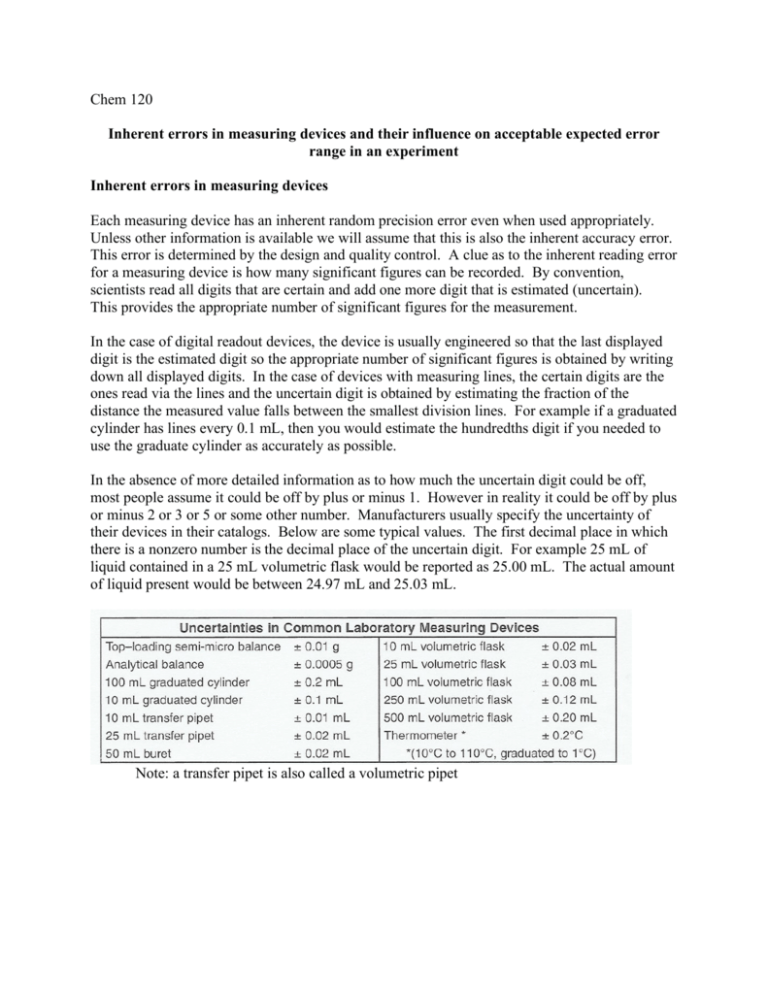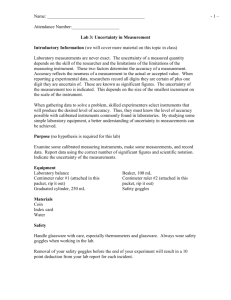Chem 120 Inherent errors in measuring devices and their influence
advertisement

Chem 120 Inherent errors in measuring devices and their influence on acceptable expected error range in an experiment Inherent errors in measuring devices Each measuring device has an inherent random precision error even when used appropriately. Unless other information is available we will assume that this is also the inherent accuracy error. This error is determined by the design and quality control. A clue as to the inherent reading error for a measuring device is how many significant figures can be recorded. By convention, scientists read all digits that are certain and add one more digit that is estimated (uncertain). This provides the appropriate number of significant figures for the measurement. In the case of digital readout devices, the device is usually engineered so that the last displayed digit is the estimated digit so the appropriate number of significant figures is obtained by writing down all displayed digits. In the case of devices with measuring lines, the certain digits are the ones read via the lines and the uncertain digit is obtained by estimating the fraction of the distance the measured value falls between the smallest division lines. For example if a graduated cylinder has lines every 0.1 mL, then you would estimate the hundredths digit if you needed to use the graduate cylinder as accurately as possible. In the absence of more detailed information as to how much the uncertain digit could be off, most people assume it could be off by plus or minus 1. However in reality it could be off by plus or minus 2 or 3 or 5 or some other number. Manufacturers usually specify the uncertainty of their devices in their catalogs. Below are some typical values. The first decimal place in which there is a nonzero number is the decimal place of the uncertain digit. For example 25 mL of liquid contained in a 25 mL volumetric flask would be reported as 25.00 mL. The actual amount of liquid present would be between 24.97 mL and 25.03 mL. Note: a transfer pipet is also called a volumetric pipet Combining errors for measuring devices to calculate the expected inherent error for an experiment (“propagation of error”) You know that when mathematical operations are done on measured numbers expressed to the proper number of significant figures, the answers must be rounded to the proper number of significant figures to show the appropriate uncertainty. Different rules are used for combining the numbers by addition or subtraction than are used for combining numbers by multiplication or division. The numerical values of uncertainty (±) values can also be combined to give a numerical uncertainty for the answer. The rules are different for when the measured numbers are added or subtracted than for when they are multiplied or divided to get the answer. One simple way of estimating the maximum uncertainty of the answer based on measuring devices is below. Addition or subtraction: When measured quantities are added or subtracted, the maximum uncertainty in the answer is the sum of the ± uncertainty values for each measurement. For example: Final volume of buret - Initial volume of buret Volume of sample delivered = = = 20.25 ± 0.02 mL 1.21 ± 0.02 mL 19.04 ± 0.04 mL Multiplication or division: When measured quantities are multiplied or divided, the uncertainty in the answer as a percent of that answer is the sum of the uncertainties in the measured numbers as a percent of the measured numbers. The following example will illustrate: Suppose a density was determined by measuring the volume of a liquid with a 10 mL transfer (volumetric) pipet and weighing it with a top-loading semi-micro balance. The mass of the 10.00 mL of liquid was 12.24 grams. The density, calculated by dividing mass by volume, would be 1.224 g/mL. From the table above, the 10 mL transfer pipet has an uncertainty of 0.01 mL. The uncertainty as a percent of the measured amount is therefore 0.01/10.00 x 100 = 0.1% From the table above, the top-loading semi-micro balance has an uncertainty of 0.01 grams. The uncertainty as a percent of the measured amount (to the proper number of significant figures) is therefore 0.01/12.24 x 100 = 0.08% The sum of these two percent uncertainties is 0.1 + 0.08 = 0.18% (0.2% to the proper number of significant figures). So the expected percent error in the experiment should be no more than 0.2%. The density answer could also be written with a ± uncertainty value in g/mL next to it. Take the percent error times the density answer to get this number. 0.18% of 1.224g/mL = 0.0022 g/mL = 0.002g/mL (to proper number of significant figures since the 0.18 was actually one sig. fig.) density = 1.224 ± 0.002 g/mL You can see that the number of significant figures we would have figured out otherwise matches with the information from the uncertainty data but that the expected error in the last digit is 2 not 1. Many times the error in one measured number is much larger than that of the other number. In such cases, the error of the more precise number will drop out and all the error can be estimated by the error in the least precise measuring device. Chem 120 Name ______________________ Section ______ Worksheet on Inherent Errors of Measuring Devices 1. Look at the following measuring devices in our lab and indicate the smallest division that can be read from the lines or digits displayed (1, 0.1, 0.01 etc.). Then indicate what you would guess the uncertainty in precision in your readings would be for those devices. 50 or 100 mL graduated cylinder 10 mL graduated pipet 10 mL graduated cylinder buret top-loader balance analytical balance Smallest division Uncertainty in precision 2. Based on the table of uncertainties for our measuring devices listed on the first page or on your table above, list the number you should record for each of the following measurements when using the device as carefully as possible. a) exactly 25 mL in a 100 mL graduated cylinder ___________ b) 25 mL in a 25 mL volumetric pipet ___________ c) exactly 9 mL in a 10-mL graduated pipet ___________ d) exactly 9 grams on an analytical balance ___________ 3. Which of the measuring devices in the table on the first page would be the most appropriate (one answer) to use if the experimental procedure said the following. In some cases you will not need to use the device to its maximum number of significant figures. In those cases you would use the device with the least number of extra significant figures. a) Weigh out 4.5g of KNO3 _______________________ b) Weigh out a 5g sample of unknown to the nearest mg _______________________ c) Wash the precipitate with two 20-mL portions of water _______________________ d) Transfer 10.00 mL of the solution prepared _______________________ e) Dilute to 100 mL (as exactly as possible) to make the standard solution. _______________________ 4. For each of the following quantities, list the measurement uncertainty as a percentage of the measured amount. (Show work). Then in each group, circle the item with the least uncertainty percentage. If two or more are tied, circle all. Uncertainty as a percent a. Measuring from a buret: b. Measuring 10 mL from a: c. Measuring 20 mL from a: 9 mL ____________ 30 mL ____________ 100 mL graduated cylinder ____________ 10 mL graduated cylinder ____________ 10 mL transfer pipet ____________ 100 mL graduated cylinder ____________ 20 mL transfer pipet ____________ (assume the same uncertainty as for a 25 mL transfer pipet) 10 mL transfer pipet filled twice ____________ 10 mL graduated cylinder filled twice __________ 5. A methanol-water solution was made in the following manner. 179.0 g of methanol was weighed into a 500 mL volumetric flask using a balance that weighs with an accuracy of ± 0.2 grams for a difference weighing. Distilled water was then added to the mark on the volumetric flask (at 20˚C). a. Calculate the % by mass of the methanol in the solution and the overall expected maximum percent error of that result based on the inherent error of the measuring devices. Show your work. (Warning: There is an item of information you need to look up. What is it?) ____________ ± ____________ % methanol % inherent error b. If the measurements were done properly, what would be the range within the actual value for % methanol would be found? From _________% methanol to _________% methanol Karen P. Long, Fall 2005









